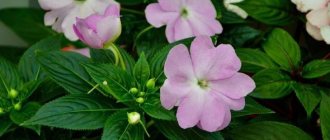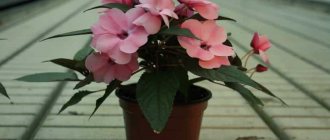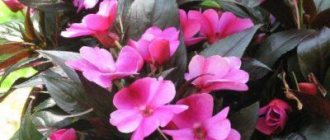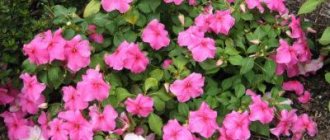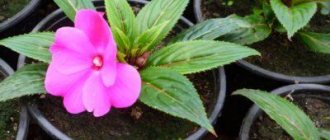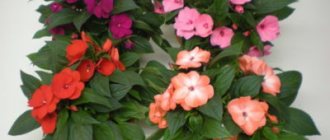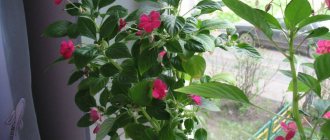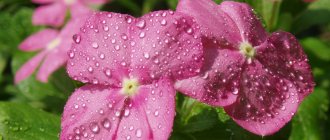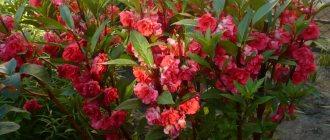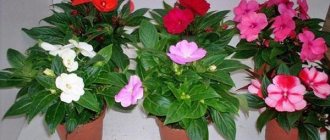The beautiful and very delicate plant impatiens (impatiens family) belongs to a large genus called Impatiens. It has over 500 plant species. The garden “career” of these plants developed with varying success: there was a time when they were admired, and then undeservedly forgotten.
Today, they are again attracting the attention of gardeners and flower lovers. Yellow, purple, crimson, pink flowers, long flowering are the main distinguishing features of these plants.
Spreading
The impatiens are native to the Himalayas. It was brought in as an ornamental plant. Prefers moist, shady areas and grows along the banks of rivers and lakes. The plant grows under natural conditions most often in tropical Africa and Asia, some representatives of the genus grow in America and Europe.
In our country, almost everywhere you can find impatiens vulgaris with small or large yellow flowers, as well as glandular, which has pink flowers. We will talk about them in this article.
Types and varieties of terry balsam
Numerous types of balsam are divided into 3 main groups of plants that differ in appearance:
- classic (traditional) - branched and spreading stems, only green leaves, double flowers white, pink, red;
- hybrid form (F1) – bushes are compact, low, with an abundance of lush flowers, the main colors are complemented by orange and purple colors;
- hybrids (New Guinea) - leaves have a variegated color.
Hybrid varieties obtained from the mother variety Waller have become widespread. The color palette is very diverse, which is appreciated in the decorative design of large and small areas.
Common hybrid varieties:
- Sparkling cherry (Sparkler Cherry) - spreading bush, large flowers are cherry-colored, dark green leaves;
- Sparkler Salmon - features double pink flowers with white veins;
- Apple Blossom – soft pink flowers in the middle are darker and lighten when the bud opens;
- Coral Bells - an ampelous hybrid plant with drooping flowers of coral-orange color;
- Balsamina Red – double, red flowers
This is interesting! Among the balsams there is an unusual species - small-flowered balsam (Impatiens parviflora). It is similar to ordinary balsam, but its size is smaller, the flowers are small, and it blooms from May until the first frost. Its peculiarity is its reaction to conditions different from the usual norms of living - the flowers do not open completely (cleistogamous flowers). The plant is unpretentious, quickly spreads on its own, so it is considered a weed.
Impatiens vulgare
Herbaceous annual plant up to 80 cm high with an erect succulent stem and fibrous branched root. The leaves are petiolate, alternate, with large teeth along the edge, oval.
The flowers are drooping, irregular, lemon-yellow in color, with a spur, usually collected in racemes. The fruit is an oblong capsule. During ripening, when you touch it, it cracks and forcefully throws out the seeds contained inside. Impatiens vulgaris blooms from the second half of June until the end of September. Prefers damp, shaded areas and forms impenetrable thickets.
The chemical composition of this plant has not yet been sufficiently studied. It is known for certain that during flowering, impatiens contain 68.5% vitamin C.
Conditions for propagation by seeds
Annuals usually reproduce by seeds that ripen in hemispherical capsules. Small seeds of impatiens impatiens (up to 100 copies in 1 gram) “shoot” several meters when touched on the walls. The possibility of germination lasts up to 8 years, however, in an environment with aggressive temperatures, seedlings do not always germinate.
- When placed on sand, they do not form inflorescences.
- In overly moist soil, the stem quickly turns black.
The best option is to grow seedlings, then plant the mature shoots in the ground. The time for sowing in boxes is February-March. If the process is delayed, the flowering time will shift accordingly.
First, the container is carefully treated with a disinfectant. Any protective fungicite of organic or inorganic origin will do. For example: “Fitosporin-M”, “Alto super”, “Amistar extra”, “Amistra trio”, copper sulfate. The substances suppress the activity of pathogenic pathogens and quickly evaporate from the soil. Although the plant is unpretentious to the quality of the soil, loose soil must correspond to the acid-base balance (pH 6.3). When filling the container, the following are added to the sheet soil in equal proportions:
- clean sand;
- vermiculite;
- peat.
Use of impatiens vulgare
The plant is used only by traditional healers. An infusion of the herb is taken as an anti-inflammatory and diuretic for diseases of the bladder, kidneys, edema, and kidney stones. In addition, it is also used as an emetic. Wounds and ulcers are washed with infusion of herbs. Baths with infusion give a good effect for joint pain. Crushed leaves are applied to bruises and hemorrhoids.
Impatiens vulgaris has long been successfully used by folk healers. For medicinal use, the plant is cut off entirely during flowering. Dry the raw materials by laying them out in the shade or in a well-ventilated area. Impatiens is used for external and internal bleeding, for stones in the bladder and kidneys.
Watering and fertilizing
For vigorous growth and flowering, adhere to the watering regime. The seedlings are moistened a couple of times a week, in hot weather - as the soil dries out. Flowers actively respond to root feeding. Nitrogen fertilizers are suitable in the period before buds set. Complexes with nitrogen inhibit the development of the ovary, but activate the growth of the green part. During flowering, potassium and phosphorus are added. Despite the proportions indicated by the manufacturer, 2 times more liquid is poured into the bucket. The recommended dose of complex feeding is divided by half. If the plants grow poorly, the leaves are small and pale in color, it is necessary to continue feeding them with nitrogen, alternating the complexes until the color is restored and growth is activated. However, excess salts also discolor paints and cause premature yellowing of foliage, so the dose should be observed. Towards the end of the season, feeding gradually stops.
Preparing the infusion
Brew two tablespoons (tablespoons) of crushed raw materials into 500 ml of boiling water in a thermos. Leave it to steep for five hours. After this time, strain. Take the product warm. During the day you need to drink 200 ml of the product in equal parts. Impatiens acts on the uterus, causing its intense contraction with heavy bleeding. In addition, this infusion is recommended for the treatment of bleeding from the bladder and rectum. It is used externally to treat ulcers, wounds, and hemorrhoids.
Impatiens vulgaris is a honey-bearing, medicinal, dyeing and poisonous plant. You shouldn’t get carried away with self-medication, even if someone you know advises you to “drink weed.”
Contraindications to treatment with balsam
First of all, it should be noted that this medicinal herb is poisonous, and therefore all dosages and duration of treatment should be strictly observed. Direct contraindications for treatment with balsam include:
- pregnancy;
- breastfeeding period;
- children under 14 years of age;
- severe diseases of the gastrointestinal tract.
Neglecting contraindications is unacceptable, as this can cause serious harm to health.
Impatiens glandular: description
This is also an annual. Grows up to two meters. The stems are straight, have internodes, often transparent, juicy, filled with juice. The leaves are alternate, elliptical in shape, entire. The plate is shiny and delicate. Their length is 10 cm, the edges are jagged.
The second name of the plant is ferruginous balsam (iron-bearing balsam). The stem of the plant is thick, highly branched, knotty, and succulent. The leaves are ovate-lanceolate and can reach 12 cm in length. They are serrated along the edges, with winged petioles. At the top of the stem they gather in whorls.
The wine-red, white, and pink flowers of this type of impatiens are large, simple, and collected in umbrella-shaped clusters of 10-14 pieces. The petals are 3-3.5 cm long. The flowers have a delicate and delicate scent and are pollinated by various insects, but most often by bumblebees.
Impatiens glandular has interesting features. During flowering, its leaves secrete drops of sweet and aromatic juice along the edges, which forms sugar crystals upon evaporation. They attract ants. During flowering, the peduncles lengthen significantly and hide, like under an umbrella, under the leaves, protecting the flowers from the rain.
The diameter of the flower (with sufficient heat and moisture) is 3 cm. In dry years, impatiens glandular is covered with small flowers, although in large quantities. They are more closed, but when the seeds from these flowers fall into a fertile environment, they produce beautiful large, well-developed flowers.
The fruit is an oblong multi-seeded juicy capsule, which consists of five valves. During ripening, the junctions of the valves become weak, and the capsule is constantly under tension. If you slightly shake the stem or slightly touch the capsule, it immediately breaks with a bang, and the dark brown seeds are scattered with force over a distance of up to two meters. Many new plants grow from them every year. Seeds are dispersed by birds and animals over long distances. They do not lose their viability for eight years.
Diseases and pests
In the flowerbed and in the photo, garden balsam looks ideal if the plant is healthy and not affected by insects. Diseases often occur under unfavorable weather conditions and poor agricultural practices. The signal may be the appearance of spots on the foliage, their withering and falling. To save plants, it is necessary to take action at the first signs of illness.
Bacteriosis
Among the main symptoms of the disease are gray-brown spots on the leaves that gradually turn black. The cause of the pathology may be the use of an infected tool, soil, or waterlogging of the soil.
The disease is contagious, so plants must be isolated, treated with copper oxychloride, and if the damage is severe, disposed of.
Powdery mildew
The presence of the disease is indicated by a white coating on the leaves. If left untreated, they soon wither and dry out. The cause may be improper watering and poor lighting.
To combat pathology, the affected parts of the plant are treated with an aqueous solution of soda ash and soap.
Mosaic
This is one of the most dangerous diseases of garden balsam. Symptoms of mosaic include yellowing of foliage, deformation, necrosis and complete drying out. The pathology is spread by thrips, soil parasites.
Important! Affected plants cannot be treated and are destroyed.
Rot
After infection with gray rot, brown spots appear on the leaves. The cause may be a decrease in air temperature or watering the plant with cold water. To combat pathology, a number of operations are performed - affected shoots are removed and treated with fungicides.
The main pests of garden balsam include spider mites, aphids and whiteflies. The most effective remedy against them is insecticides (Decis, Actellik, Fitoverm).
Touchy and magic
In ancient times, it was believed that the impatiens glandular was capable of magically opening locks and destroying prison bolts with one touch. It was believed that the flower could tear gold and silver, iron and copper into small pieces. Thieves who found a touch-me-not made a cut in the palm of their hand, inserted grass into it, and then healed the wound. At the touch of such a hand, locks allegedly fell from the doors.
People believed that everyone who simply carried this plant in their pocket was reliably protected from any bullet. This herb, thrown into the enemy’s forge, deprived him of the ability to forge iron. But not every touch-me-not had magical properties, but only those that were obtained in compliance with special rituals.
It was necessary to find a hollow in which the woodpecker had built a nest, and at the same time there were already chicks in it. Then we had to wait for the mother bird to fly away, and then close the nest tightly. Seeing that the nest is closed, the bird will definitely bring an impatiens stem. With his light touch the hollow will open. At this moment, the observing person should have screamed loudly so that the frightened bird would drop the grass.
Brief overview of species
Annual and perennial herbaceous shrubs with lanceolate curly leaves and fibrous roots have different configurations and growth. If dwarf varieties grow up to 25 cm, giant species sometimes reach 2 m. Among the numerous species (almost 500), medium-sized specimens (70 cm) are most widespread. Cultivated species are classified into 3 groups:
- New Guinea perennial hybrids with variegated foliage.
- Waller's Impatiens (erect perennial).
- Annual garden balsam.
Ground cover ampelous varieties with many shoots luxuriously cover borders. A frequently encountered species is an upright bush. Garden balsam belongs to this group. For the drops hanging from the leaves, the balsam is called “Vanka wet”, for the diversity of colors - “Ogonyok”, and its long flowering - “Eternal Flower”. They dubbed it touchy for the ability of the box to open with a light touch.
“Vanka wet” in the selection collection is represented by several varieties: tall “Camellia Flowered”, short “Tot Thumb”. This group includes the exotic Balfour's Balsam, which does not take root in our climate. Erect shrubs of the “Iron-bearing” species grow up to 2 m, the garden height reaches from 70 cm to 1 m. The bushes are decorated with pink, light, purple buds located on leafy branches with a reddish tint.
Breeding in the garden
Impatiens glandularis is the largest plant of its genus. It is rarely grown in rural front gardens, since it produces abundant self-sowing, often “runs away” behind the fence and forms solid thickets of succulent stems. And gardeners and owners of country houses love balsams. They look great in a border, edging, or as the centerpiece of a flower bed.
Impatiens can also become a perennial plant. If you grew it in the garden or on the balcony, cut the cuttings and grow the flower indoors in winter. The only drawback of this procedure is the falling of leaves in insufficient light.
It is best to plant impatiens in the garden, in a well-ventilated, fairly sunny location with soil rich in organic matter. Gardeners need to know that impatiens take a lot of nitrogen out of it, and therefore grow quite quickly. On poor soils they almost never reach their maximum size. Impatiens especially do not like thickening: the plants become stunted and flowering ends very quickly.
This type is not used in medicine. Gardeners need to be careful when working with this plant. The fact is that impatiens glandular is poisonous. And one more piece of advice. You should not plant this plant if there are small children in the family.
Impatiens cuttings
If annuals are grown from seeds, the vegetative method of propagation by leaves or a piece of stem is relevant for perennials. Hybrid New Guinea varieties of Waller's balsam reproduce only in this way. Cuttings completely preserve varietal qualities. Growing grains is possible if they are sold by seed companies. Seedlings from boxes grown on a personal plot rarely sprout.
The principle of cuttings is as follows. Fragments of the plant - a piece of stem, a leaf - are placed in a bowl with water and left in a well-lit place. After a week, roots emerge and take root well in the substrate. After a few months, the buds open. Using this technology, reproduction is allowed during the growing season.
Advice! A few days before the process, the plant is fed, the pot is placed in a poorly lit room to form long shoots. The tops and leaves from below are cut off and sent to containers with boiled water at room temperature. In response to attention and care, the “touch-me-not” will reward you with lush flowering throughout the years.
Share
Waller's Impatiens (Impatiens walleriana)
Waller's balsam, the most common on Russian windows and also used for seasonal outdoor landscaping, has many names. Since the discovery of the plant in the mid-19th century, it has been called Impatiens sultanii in honor of the ruler of Zanzibar, the birthplace of this ornamental crop.
For many years now, Russian flower growers have been well acquainted with this species under the slightly familiar nickname of balsam Vanka Mokry or under the popular name “light” for the brightness of the flowers flaming on the bush. Because of its love for water and its many colors, balsam is also called “water fuchsia.”
Unlike its garden counterpart, Waller's balsam is a very small perennial plant. In indoor conditions, the culture produces a compact branching bush up to 30–40 cm high. In indoor conditions, plants turn out taller than in the garden, and with regular pinching they bush well and do not lose their decorative appearance for several years.
In the garden, Waller's balsams are somewhat lower and can grow and bloom only in the summer months in the absence of destructive frosts. The crop is planted as seedlings in the ground, and flowering begins 50–70 days after transplanting to a permanent location.
This species stands out for its single flowers, which have a flattened shape and a variety of colors. Plants prefer places that are protected from drafts and in partial shade. The sun makes the color of the flowers duller, and the wind can easily break the shoots that are fragile at the nodes.
Once in the hands of breeders, the culture produced many spectacular, photo-like, popular varieties of balsam. The range and variety of flowers bred are simply amazing, but with all their diligence, botanists are unable to obtain plants with flowers of yellow and blue shades. Waller's balsam varieties and hybrids are grouped into groups that are similar in corolla shape, flowering time and other external characteristics of plants. This is done for ease of classification and convenience for gardeners.
For example, an extensive group of Impreza hybrid balsams are plants 15–20 cm high, with strong stems, short internodes and an excellent ability to form lateral shoots. The series includes plants with crimson, violet and carmine, simple flowers. As well as specimens with original white or slightly pink corollas, decorated with a bright red spot in the center.
Today, the most popular varieties of balsams are those with lush double flowers. Large corollas make the plant more decorative and attractive.
In addition to varieties with erect shoots, flower growers are offered ampelous impatiens impatiens, which grow well in hanging baskets and flowerpots, suitable for decorating not only interiors, but also open terraces in a country house.
Outdoors, Waller's balsams bloom during the summer season; indoors, bud formation occurs continuously, but only when maintaining a relatively low temperature within 16–19 °C.
Proper care
Impatiens is an unpretentious plant; it is often found both in summer cottages and city flower beds, and on window sills. Caring for it, simple and timely updating will keep the flower in a beautiful and blooming form.
- Impatiens grows well in sunny areas and partial shade. However, it is advisable to choose a place for planting that is sunny, with fertile, loose soil. Indoor varieties are recommended to be grown on eastern and southern windows. In the shade, the branches of the plant will begin to stretch out and the flower will lose its decorative appearance and the density of the bush, and the number of flowers will also decrease.
- The plant does not tolerate dry weather well and needs regular watering. But waterlogging of the soil leads to rotting of the roots and death of the entire plant. Therefore, watering is carried out regularly, checking the soil for moisture each time. This applies to both indoor varieties and those grown in gardens and open areas.
- Dry air has a detrimental effect on impatiens; when watering, it is recommended to moisten the leaves with a spray bottle. If the air is constantly dry, spider mites may appear on the branches.
- After watering, the soil is loosened and weeds are removed. This process will allow excess water to escape and allow the roots to let in additional air. Weeds also create density, which can lead to rotting of the lower branches and roots.
- Impatiens are planted in open ground only when the weather becomes consistently warm and the soil warms up well. Typically this period falls at the beginning of June. The soil can be fertilized with compost, dug up and watered.
- Holes for seedlings are dug at a distance of 30 cm from each other so that the plant has room to develop. Temperatures below +5 degrees have a detrimental effect on the plant, its growth slows down and with prolonged cold weather the bush dies.
- Fertilizing is carried out regularly during the growing season. A weakly concentrated complex fertilizer is suitable for this. It should not contain nitrogen, which will increase the number of leaves and reduce the amount of flowering.
- To preserve decorativeness and stimulate the growth of new buds, it is recommended to remove wilted flowers. The plant does not need pruning, as it forms a bush on its own.
- Every 2-3 years, indoor varieties need to be updated. In this case, the mother bush is thrown away, and cuttings cut from it are rooted and planted in its place.
Collection and preparation of medicinal raw materials
In medical practice, the upper part (except for the roots) is used. Collection is recommended during the flowering period, when there is an increased concentration of beneficial components. The collected material is laid out under a canopy on a flat surface. The thickness of the grass layer should not exceed 5 cm.
The seed pods are carefully removed from the plant and dried under artificial conditions. The collected material is stored in separate paper bags, on which the date of collection is indicated. When storing raw materials, it is important to maintain the level of humidity and temperature, which affect the quality of the material.
Garden Balsam in landscape design
Garden Light can be used in garden decoration for various functional and aesthetic purposes due to the presence of many varieties of this plant. They will decorate borders and paths, create a beautiful background or add a bright accent to the heart of the entire composition.
They are planted in pots in small garden areas for vertical gardening. The exterior of buildings is also decorated in this way. Container Balsams will become bright lights near recreation areas and in courtyard areas. Verbena, Fuchsia, Begonia will be excellent “neighbors”.
If you use group planting, you can get a whole field of incredibly luxurious flowers. The use of balsams of various shades will give the garden an enchanting sound. This plant allows you to realize the full creative potential of the owner of the site and is guaranteed to get a positive result from your work.
